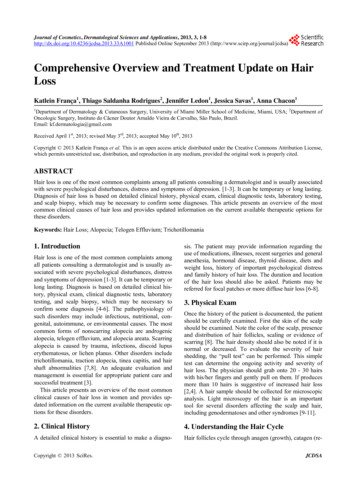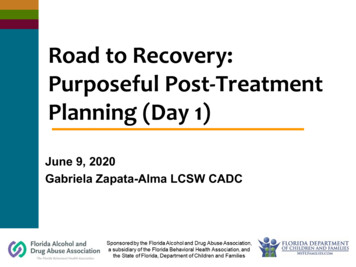
Transcription
1Journal of Cosmetics, Dermatological Sciences and Applications, 2013, 3, 1-8http://dx.doi.org/10.4236/jcdsa.2013.33A1001 Published Online September 2013 (http://www.scirp.org/journal/jcdsa)Comprehensive Overview and Treatment Update on HairLossKatlein França1, Thiago Saldanha Rodrigues2, Jennifer Ledon1, Jessica Savas1, Anna Chacon11Department of Dermatology & Cutaneous Surgery, University of Miami Miller School of Medicine, Miami, USA; 2Department ofOncologic Surgery, Instituto do Câcner Doutor Arnaldo Vieira de Carvalho, São Paulo, Brazil.Email: kf.dermatologia@gmail.comReceived April 1st, 2013; revised May 3rd, 2013; accepted May 10th, 2013Copyright 2013 Katlein França et al. This is an open access article distributed under the Creative Commons Attribution License,which permits unrestricted use, distribution, and reproduction in any medium, provided the original work is properly cited.ABSTRACTHair loss is one of the most common complaints among all patients consulting a dermatologist and is usually associatedwith severe psychological disturbances, distress and symptoms of depression. [1-3]. It can be temporary or long lasting.Diagnosis of hair loss is based on detailed clinical history, physical exam, clinical diagnostic tests, laboratory testing,and scalp biopsy, which may be necessary to confirm some diagnoses. This article presents an overview of the mostcommon clinical causes of hair loss and provides updated information on the current available therapeutic options forthese disorders.Keywords: Hair Loss; Alopecia; Telogen Effluvium; Trichotillomania1. IntroductionHair loss is one of the most common complaints amongall patients consulting a dermatologist and is usually associated with severe psychological disturbances, distressand symptoms of depression [1-3]. It can be temporary orlong lasting. Diagnosis is based on detailed clinical history, physical exam, clinical diagnostic tests, laboratorytesting, and scalp biopsy, which may be necessary toconfirm some diagnosis [4-6]. The pathophysiology ofsuch disorders may include infectious, nutritional, congenital, autoimmune, or environmental causes. The mostcommon forms of nonscarring alopecia are androgenicalopecia, telogen effluvium, and alopecia areata. Scarringalopecia is caused by trauma, infections, discoid lupuserythematosus, or lichen planus. Other disorders includetrichotillomania, traction alopecia, tinea capitis, and hairshaft abnormalities [7,8]. An adequate evaluation andmanagement is essential for appropriate patient care andsuccessful treatment [3].This article presents an overview of the most commonclinical causes of hair loss in women and provides updated information on the current available therapeutic options for these disorders.sis. The patient may provide information regarding theuse of medications, illnesses, recent surgeries and generalanesthesia, hormonal disease, thyroid disease, diets andweight loss, history of important psychological distressand family history of hair loss. The duration and locationof the hair loss should also be asked. Patients may bereferred for focal patches or more diffuse hair loss [6-8].3. Physical ExamOnce the history of the patient is documented, the patientshould be carefully examined. First the skin of the scalpshould be examined. Note the color of the scalp, presenceand distribution of hair follicles, scaling or evidence ofscarring [8]. The hair density should also be noted if it isnormal or decreased. To evaluate the severity of hairshedding, the “pull test” can be performed. This simpletest can determine the ongoing activity and severity ofhair loss. The physician should grab onto 20 - 30 hairswith his/her fingers and gently pull on them. If producesmore than 10 hairs is suggestive of increased hair loss[2,4]. A hair sample should be collected for microscopicanalysis. Light microscopy of the hair is an importanttool for several disorders affecting the scalp and hair,including genodermatoses and other syndromes [9-11].2. Clinical History4. Understanding the Hair CycleA detailed clinical history is essential to make a diagno-Hair follicles cycle through anagen (growth), catagen (re-Copyright 2013 SciRes.JCDSA
Comprehensive Overview and Treatment Update on Hair Loss2gression) and telogen (resting) phases (Table 1). Understanding this process is clinically important, since thevast majority of patients with hair disorders suffer froman undesired alteration of hair follicle cycling [12,13].Anagen hair loss occurs due to disorders that stop the mitotic activity of anagen follicles, such as alopecia areataand drugs [4,14]. On the other hand, telogen hair lossoccurs due to injuries that may cause premature follicletelogenization [4,15].5. Alopecia5.1. Androgenetic AlopeciaAndrogenetic alopecia (AGA) is the most common formof hair loss. When it affects women, it leads to diffusealopecia over the mid-frontal scalp (female pattern hairloss) [16]. This process is a result of hair follicle miniaturization within follicular units. It represents a progressive reduction in diameter, pigmentation and length ofthe hair shaft [4,17]. These miniaturized hairs are thehallmark of AGA. Most women with AGA have normalmenses and pregnancies. 18 This disorder is induced byandrogens in genetically susceptible persons. These patients present hair follicles with increased 5α-reductaseactivity and dihydrotestosterone (DHT) levels. In thesegenetically susceptible hair follicles, the DHT binds tothe androgen receptor and the hormone-receptor complex,activating the genes responsible for the transformation ofthe normal hair follicle in miniaturized follicles [18,19].The reduction in the number of terminal fibers per follicular unit will produce a diffuse alopecia [17]. The impact of androgenetic alopecia is predominantly psychological. While men anticipate age-related hair loss, thesame process in women is usually unexpected and unwelcome at any time [20,21] (Figure 1).Association with thyroid disorders is suggested bysome authors, but alopecia is unaffected by thyroid substitution [21]. This disorder can be precipitated or worsened by conditions that induce telogen effluvium such aspostpartum telogen effluvium. If associated with hirsutism and acne, AGA can be a sign of hyperandrogenism in premenopausal women [4]. Pharmacological-containing estrogens (contraception) have a beneficial effecton such alopecia, probably through different mechanisms:anti-androgen effect increased and proliferative effect ofdermal papilla cells [22]. But contraceptives that containandrogenic progestins like nortestosterone-derivates levonorgestrel may induce or worsen this condition [4,22,23].Levonorgestrel intrauterine device has been described ascause of hair loss [24].5.2. Alopecia AreataAlopecia areata (AA) is a nonscarring autoimmune, inflammatory scalp, and/or body hair loss condition [25]. Itaffects up to 2% of the population and it is characterizedby patchy hair loss (Figure 2). It can affect the entirescalp (alopecia totalis) or cause loss of all body hair(alopecia universalis) [4,26]. Histopathology shows anincreased number of the catagen and telogen follicles andthe presence of an inflammatory lymphocytic infiltrate inthe peribulbar region [25].Figure 1. A 55-year-old male presenting androgeneticalopecia.Table 1. Hair cycle phases.The follicles produce the hair shaft. Duration ranges fromAnagen two to seven years. Up to 85% of the hair is in this phaseat one time.CatagenTransitional phase that lasts two to three weeks whichprecedes the resting telogen phaseTelogenHair production is absent. Up to 15% of hair is in thisphase at one time and it can last 3 months.Copyright 2013 SciRes.Figure 2. Alopecia areata in a 64-year-old female.JCDSA
Comprehensive Overview and Treatment Update on Hair LossMany factors are under investigation to clarify the pathogenesis of AA. Nonspecific immune and organ-specific autoimmune reactions and genetic constitution arepossible causes [27,28].One of the most discussed ideas is that genetically predisposed individuals present an autoimmune T cell-mediated-reaction against the hair follicle [28]. This processmay be caused by different triggering factors, such as viral infections and stress [4,29]. It can be associated withother autoimmune disorders, such as thyroid disease [4].The influence of psychological factors in the development, evolution and therapeutic management of alopecia areata is documented by several authors. The comorbidity of psychiatric disorders, mainly depression, generalized anxiety disorder and phobic states, is high [30,31].Postoperative alopecia areata following surgery hasbeen reported after gynecologic and cardiac procedures.Although pressure-induced ischemia is the most likelyetiological factor, a study conducted by Khalaf and colleagues showed that these patients might also presentwith psychiatric comorbidities, questioning the real etiology of AA in these patients [32].3Figure 3. Chemotherapy induced alopecia.5.3. Chemotherapy Induced AlopeciaMost cytotoxic anticancer chemotherapy agents inducealopecia by ablating the rapidly dividing epithelium ofthe hair follicle. The overall incidence of chemotherapyinduced hair loss is estimated to be 65% and the severityand prevalence of this type of hair loss is related to theselected chemotherapeutic agent and treatment protocol[33]. Chemotherapy-induced anagen effluvium is usuallyreversible, but it’s known that certain chemotherapy regimens can cause permanent alopecia. In these cases, moderate to very severe hair thinning and altered texturemay be seen when hair regrows [34]. Although it is transient, chemotherapy-induced alopecia it is often psychologically devastating, especially for women [35,36] (Figures 3 and 4).5.4. TrichotillomaniaTrichotillomania, also known as hair pulling disorder, isan impulse-control disorder that affects at least 3.7 million people in the United States and results in markedfunctional impairment [37,38]. This disease is characterized by an irresistible desire to manipulate and pull outthe hair [4]. The disorder typically onsets in childhoodeither in preschool or in the preadolescent years and is upto seven times more commonly found in the pediatricpopulation than in adults [39]. The disorder may begin asa habit, similar to nail-biting or thumb-sucking [40]. Onphysical examination, irregular patches of hair loss withbizarre borders can be observed. Inside of these patches,short and broken hairs with variable lengths are evidentCopyright 2013 SciRes.Figure 4. Eyebrow hair loss in a female patient undergoingchemotherapy.[4]. Appropriate psychoeducation and minimally invasive behavioral treatments are possible interventions forthis common disorder [41,42].6. Telogen EffluviumTelogen effluvium (TE) is an increased loss of normalclub hairs that occurs by a perturbation of the hair cycle[43]. It was first described by Kligman in 1961 and hishypothesis was that whatever the cause of hair loss, thefollicle tends to behave in a similar way, causing premature termination of anagen [43,44]. The true incidence isunknown because many cases are subclinical [45]. Common causes of TE include iron deficiency, drugs andstress (Table 2).6.1. Acute Telogen EffluviumThe first description of classic telogen effluvium was anacute onset hair loss 2 - 3 months after a triggering eventsuch as surgical trauma or high fever [46]. Other knowncauses include drugs, stress, fever, weight loss, hypothyroidism, hyperthyroidism, and other disorders that maycause inflammation of the scalp, such as contact dermatitis [45,47]. In cases where no cause is found, screeningfor thyroid disease, antinuclear antibody and syphilisshould be performed. Acute TE does not usually producevisible alopecia; the patient often complains that the hairJCDSA
Comprehensive Overview and Treatment Update on Hair Loss4Table 2. Common causes of telogen effluvium.Nutritional /hyperthyroidismHepatic failureChronic renal failure6.1.4. PostpartumPostpartum hair loss usually starts two to four monthsafter delivery and may last six months to one year [55].Although the prevalence of postpartum alopecia is notknown, it is believed to be common. Patients without nutritional deficiencies or other diseases will achieve complete recovery after an additional six to nine months, butphysicians should keep in mind that this condition canprecipitate the development of alopecia areata in predisposed patients [54,55]. The hair loss is always diffuse butnever total. Some patients may experience slower growthwith decreased hair density [55,56].Idiopathic6.2. Chronic Telogen Effluviumis falling out. Daily shedding of 100 to 200 telogen hairscan be observed in severe cases [4].6.1.1. Nutritional DeficiencyOne of the most common causes of hair loss in premenopausal women is nutritional deficiency of iron. Screeningfor serum ferritin and hemoglobin should be performedto clarify the possible cause of hair loss in this population[48]. Iron supplementation is recommended when levelsof ferritin are below 30 ng/ml [4]. Severe protein, caloricrestriction, vitamin D deficiency, zinc deficiency and chronic starvation can also induce diffuse telogen hair loss[49,50].6.1.2. StressEvidence of the data suggests that neurotransmitters,neurohormones, and cytokines released during the stressresponse may also significantly influence the hair cycle[51]. Arck and colleagues provided further evidence forexistence of a “brain-hair follicle axis”. This theory saysthat audiogenic stress also induces significant changes inactively growing hair follicles and promotes their transition into the involution phase [52].6.1.3. DrugsHair loss can be an adverse effect of a large number ofdrugs. The severity of alopecia will depend on the drugand individual predisposition. While some drugs willproduce only hair abnormalities others will produce severe hair loss, even with appropriate dosages. Drugs affect anagen follicles by two different processes: precipitating the follicles into premature rest (telogen effluvium)or inducing an abrupt cessation of mitotic activity in rapidly dividing hair matrix cells (anagen effluvium). Anticoagulants, retinol, interferon, antihyperlipidemic drugsare just a few examples of drugs that can induce telogeneffluvium [52]. Hair loss from the scalp, eyebrows, andpubic area was identified as a possible adverse effect ofmost psychotropic medications. This process is usuallyreversible after interruption of treatment [53].Copyright 2013 SciRes.This condition is characterized by hair shedding lastinglonger than 6 months, and with a fluctuating chronic course over many years. It is idiopathic and usually a triggercannot be identified [2,4]. The diagnosis of chronic telogen effluvium is made by the exclusion of causes ofdiffuse telogen hair loss, including androgenetic alopecia[8]. Scalp pain and reduced hair density is commonly reported by patients.7. Treatment7.1. Androgenetic Alopecia7.1.1. Topical MinoxidilTopical Minoxidil is now the most widely recommendedtreatment for androgenetic alopecia. It is available in 2%and 5% solutions for hair loss. The 2% solution is theonly one approved by FDA for use in female patients. Itstimulates new hair growth and helps stop the loss of hairin individuals with androgenetic alopecia (AGA) [57-59].Side effects include a transient shedding during the first 4months of use and contact dermatitis [60].7.1.2. FinasterideFinasteride is a synthetic type-2 5α-reductase inhibitorand has been studied by several authors as a treatment forfemale pattern hair loss. A review study published in2011 shows that objective evidence of efficacy is limited,but it may be considered as a treatment for patients whofail topical minoxidil [61]. Finasteride is well tolerated;however, premenopausal patients must adhere to reliablecontraception while receiving it. The dosage of 2.5mg/daily seems to show better results when compared to1.0 mg/daily. It is contraindicated in pregnancy, due toknown teratogenicity. For men, the dosage is 1 mg oncea daily [62].7.2. Anti-Hormonal TherapyReviews suggest that anti-hormonal therapy is helpful intreating female pattern alopecia in some women whoJCDSA
Comprehensive Overview and Treatment Update on Hair Losshave normal hormone levels.Spironolactone is an aldosterone antagonist employedin clinical practice as a potassium-sparing diuretic. Itreduces adrenal androgen production and exerts competitive blockade on androgen receptors in target tissues [63].This medication has been used off-label in female patternhar loss for over 20 years and it has been shown to arresthair loss progression with a long-term safety profile. Itshould not be used in pregnancy due to its teratogenic effects [64].Cyproterone acetate is an androgen receptor blockerwith strong progestational activity and a weak glucocorticoid action. It seems to decrease hair shedding, but doesnot seem to promote regrowth [65]. The dose requiredfor premenopausal women is 100 mg daily for 10 days ofeach menstrual cycle and postmenopausal women shoulduse 50 mg daily continuously. Sinclair and colleaguesperformed an intervention study involving eighty femalepatients with FPHL to evaluate the efficacy of oral antiandrogen therapy in the management of women withFPHL. Forty patients received spironolactone 200 mgdaily and 40 received cyproterone acetate, either 50 mgdaily or 100 mg for 10 days per month if premenopausal.This study showed no significant difference in the resultsor the trend between spironolactone and cyproteroneacetate. Thirty-five (44%) women had hair regrowth, 35(44%) had no clear change in hair density before andafter treatment, and only 10 (12%) experienced continuing hair loss during the treatment period [66].7.2.1. Alopecia AreataTreatment is not mandatory considering it a benign condition. Spontaneous remissions and recurrences are common. Some therapeutic agents can be effective. This listincludes systemic, intralesional and topical steroids underocclusion and topical immunotherapy with squaric aciddibutylester or diphencyprone [67-69].7.2.2. Chemotherapy Induced AlopeciaScalp cooling is as a method of preventing hair loss during chemotherapy and it has been discussed by severalauthors as an effective option [70,71]. Topical 2% minoxidil as a therapy for accelerating regrowth after chemotherapy has also proven to shorten the baldness period[72]. Psychological support, education, and self-care strategies are important components of any managementapproach [73].7.2.3. TrichotillomaniaBehavior therapy and pharmacotherapy are the most efficacious treatments for adult trichotillomania and haveshown significant reductions in hair pulling over theshort term. [74] Pharmacotherapy agents include selective serotonin inhibitors at high dosage and domipramine.Copyright 2013 SciRes.5Recent developments in pharmacotherapy have suggested that other medications such as opioid blockers,atypical neuroleptics, and glutamate modulators hold promise as treatment for trichotillomania. [75]7.3. Telogen Effluvium7.3.1. Iron SupplementationFemale patients without systemic inflammation or otherunderlying disorders, serum ferritin levels below or equalto 30 ng/mL are strongly associated with telogen hairloss [76,77]. Iron supplementation with oral iron sulphateis recommended until a serum ferritin level of 70 ng/mlis achieved [4].7.3.2. Biotin SupplementationBiotin also known as vitamin H or coenzyme R has beenshown to improve clinical appearance and combing problems in patients with uncombable hair syndrome [78]. Astudy performed by Shelley and colleagues showed theeffectiveness of the biotin treatment in increasing theroot strength, in making the scaling disappear, and inaccelerating the growth rate, hence the hair became morepliable and combable. The recommended supplementation is 5 mg daily [78].7.3.3. Cysteine SupplementationIt is unclear whether cysteine supplements will improvethe quality of hair and the growth cycle. Available clinical data do not prove or disprove this theory. The recommended dosage is 500 mg daily.REFERENCES[1]J. V. Schmitt, C. F. Ribeiro, F. H. Souza, E. B. Siqueiraand F. R. Bebber, “Hair Loss Perception and Symptomsof Depression in Female Outpatients Attending a GeneralDermatology Clinic,” Anais Brasileiros de Dermatologia,Vol. 87, No. 3, 2012, pp. 412-417.doi:10.1590/S0365-05962012000300010[2]S. B. Shrivastava, “Diffuse Hair Loss in an Adult Female:Approach to Diagnosis and Management,” Indian Journalof Dermatology, Venereology and Leprology, Vol. 75, No.1, 2009, pp. 20-28. doi:10.4103/0378-6323.45215[3]M. B. Chartier, D. M. Hoss and J. M .Grant-Kels, “Approach to the Adult Female Patient with Diffuse Nonscarring Alopecia,” Journal of the American Academy of Dermatology, Vol. 47, No. 6, 2002, pp. 809-818.doi:10.1067/mjd.2002.128771[4]A. Tosti, B. M. Piraccini, A. Sisti and B. Duque-Estrada“Hair Loss in Women,” Minerva Ginecologica, Vol. 61,No. 5, 2009, pp. 445-52[5]E. B. Hawryluk and J. C. English, “Female AdolescentHair Disorders,” Journal of Pediatric and AdolescentGynecology, Vol. 22, No. 4, 2009, pp. 271-281.doi:10.1016/j.jpag.2009.03.007JCDSA
Comprehensive Overview and Treatment Update on Hair Loss6[6]A. L. Mounsey and S. W. Reed, “Diagnosing and Treating Hair Loss,” American Family Physician, Vol. 80, No.4, 2009, pp. 356-362.[7]J. Shapiro, M. Wiseman and H. Lui “Practical Management of Hair Loss,” Canadian Family Physician, Vol. 46,No. 7, 2000, pp. 1469-1477.[8][9]F. Mulinari-Brenner and W. F. Bergfeld, “Hair Loss: AnOverview,” Dermatology Nursing, Vol. 13, No. 4, 2001,pp. 269-272, 277-278.H. H. Celik, H. Tore, S. Tunali, I. Tatar and M. M. Aldur,“Light and Scanning Electron Microscopic Examinationof Hair in Griscelli Syndrome,” Saudi Medical Journal,Vol. 28, No. 8, 2007, pp. 1275-1277.[10] V. V. Smith, G. Anderson, M. Malone and N. J. Sebire“Light Microscopic Examination of Scalp Hair Samplesas an Aid in the Diagnosis of Pediatric Disorders: Retrospective Review of More Than 300 Cases from a SingleCenter,” Journal of Clinical Pathology, Vol. 58, No. 12,2005, pp. 1294-1298. doi:10.1136/jcp.2005.027581standing,” International Journal of Dermatology, Vol. 37,No. 8, 1998, pp. 561-566,[21] C. Jamin, “Androgenetic Alopecia,” Annales De Dermatologie Et De Venereologie, Vol. 129, 2002, pp. 801-803.[22] H. Zaun, “Influence of Contraceptive Hormones on HairGrowth,” Deutsche Medizinische Wochenschrift, Vol. 103,No. 6, 1978, p. 240.[23] H. Zaun, “Skin Changes from Taking Hormonal Contraceptives,” Medizinische Monatsschrift für Pharmazeuten,Vol. 4, No. 6, 1981 pp. 161-165.[24] H. Paterson, J. Clifton, D. Miller, J. Ashton and M. Harrison-Woolrych, “Hair Loss with Use of the Levonor-gestrel Intrauterine Device,” Contraception, Vol. 76, No.4, 2007, pp. ] D. Wasserman, D. A. Guzman-Sanchez, K. Scott and A.McMichael, “Alopecia Areata,” International Journal ofDermatology, Vol. 46, No. 2, 2007, pp. 121-131.doi:10.1111/j.1365-4632.2007.03193.x[11] K. A Adya, A.C Inamadar, A. Palit, R. Shivanna and N. SDeshmukh, “Light Microscopy of the Hair: A SimpleTool to ‘Untangle’ Hair Disorders,” International Journalof Trichology, Vol. 3, No. 1, 2011, pp. 46-56.doi:10.4103/0974-7753.82124[26] F. M. Delamere, M. J. Sladden, H. M. Dobbins and J.Leonardi-Bee, “Interventions for Alopecia Areata,” Cochrane Database of Systematic Reviews, No. 2, 2008, Article ID: CD004413.doi:10.1002/14651858.CD004413.pub2[12] R. Paus and K. Foitzik, “In Search of the ‘Hair Cycleclock’: A Guided Tour,” Differentiation, Vol. 72, No.9-10, 2004, pp. ] A. Gilhar and R. S. Kalish, “Alopecia Areata: A TissueSpecific Autoimmune Disease of the Hair Follicle,” Autoimmunity Reviews, Vol. 5, No. 1, 2006, pp. 64-69.doi:10.1016/j.autrev.2005.07.001[13] M. Kimura-Ueki, Y. Oda, J. Oki, A. Komi-Kuramochi, E.Honda, M. Asada, M. Suzuki and T. Imamura, “Hair Cycle Resting Phase is Regulated by Cyclic EpithelialFGF18 Signaling,” Journal of Investigative Dermatology,Vol. 132, No. 5, 2012, pp. 1338-1345.doi:10.1038/jid.2011.490[28] S. Madani and J. Shapiro, “Alopecia Areata Update,”Journal of the American Academy of Dermatology, Vol.42, No. 4, 2000, pp. 49-66.[14] M. Courtois, G. Loussouarn, C. Hourseau and J. F. Grollier, “Hair Cycle and Alopecia,” Skin Pharmacology, Vol.7, No. 1-2, 1994, pp. 84-89. doi:10.1159/000211279[15] S. Harrison and R. Sinclair, “Telogen Effluvium,” Clinical and Experimental Dermatology, Vol. 27, No. 5, 2002,pp. 389-395. doi:10.1046/j.1365-2230.2002.01080.x[16] O. T. Norwood, “Incidence of Female Androgenetic Alopecia (Female Pattern Alopecia),” Dermatologic Surgery,Vol. 27, No. 1, 2001, pp. 53-54.doi:10.1111/j.1524-4725.2001.00124.x[17] R. Sinclair, M. Patel, T. L. Dawson Jr., A. Yazdabadi, L.Yip, A. Perez and N. W. Rufaut, “Hair Loss in Women:Medical and Cosmetic Approaches to Increase Scalp HairFullness,” British Journal of Dermatology, Vol. 165,Suppl. 3, 2011, pp. 12-18.doi:10.1111/j.1365-2133.2011.10630.x[18] V. H. Price, “Androgenetic Alopecia in Women,” Journalof Investigative Dermatology Symposium, Vol. 8, No. 1,2003, pp. 24-27. doi:10.1046/j.1523-1747.2003.12168.x[29] M. J. García-Hernández, S. Ruiz-Doblado, A. RodriguezPichardo and F. Camacho, “Alopecia Areata, Stress andPsychiatric Disorders: A Review,” The Journal of Dermatology, Vol. 26, No. 10, 1999, pp. 625-632.[30] S. Ruiz-Doblado, A. Carrizosa and M. J. García-Hernández, “Alopecia Areata: Psychiatric Comorbidity andAdjustment to Illness,” International Journal of Dermatology, Vol. 42, No. 6, 2003, pp. 434-437.doi:10.1046/j.1365-4362.2003.01340.x[31] H. Khalaf, H. Negmi, G. Hassan, M. Al-Sebayel, “Postoperative Alopecia Areata: Is Pressure-Induced Ischemiathe Only Cause to Blame?” Transplantation Proceedings,Vol. 36, No. 7, 2004, pp. 2] R. M. Trüeb, “Chemotherapy-Induced Hair Loss,” SkinTherapy Letter, Vol. 15, No. 7, 2010, pp. 5-7.[33] D. Gude, “Tackling Chemotherapy-Induced Alopecia,”International Journal of Trichology, Vol. 4, No. 1, 2012,pp. 47-48. doi:10.4103/0974-7753.96098[19] V. K. Soni, “Androgenic Alopecia: A CounterproductiveOutcome of the Anabolic Effect of Androgens,” MedicalHypotheses, Vol. 73, No. 3, 2009, pp. 420-426.doi:10.1016/j.mehy.2009.03.032[34] I. R. Kim, J. Cho, E. K. Choi, I. G. Kwon, Y. H. Sung, J.E. Lee, S. J. Nam and J. H. Yang, “Perception, Attitudes,Preparedness and Experience of Chemotherapy-InducedAlopecia among Breast Cancer Patients: A QualitativeStudy,” Asian Pacific Journal of Cancer Prevention, Vol.13, No. 4, 2012, pp. 1383-1388.doi:10.7314/APJCP.2012.13.4.1383[20] D. A.Whiting, “Male Pattern Hair Loss: Current Under-[35] H. Roe, “Chemotherapy-Induced Alopecia: Advice andCopyright 2013 SciRes.JCDSA
Comprehensive Overview and Treatment Update on Hair LossSupport for Hair Loss,” British Journal of Nursing, Vol.20, No. 10, 2011, pp. S4-S11.[36] N. Shoenfeld, O. Rosenberg, M. Kotler and P. N. Dannon,“Tricotillomania: Pathopsychology Theories and Treatment Possibilities,” The Israel Medical Association Journal, Vol. 14, No. 2, 2012, pp. 125-129.[37] C. A. Flessner, V. S. Knopik and J. McGeary, “Hair Pulling Disorder (Trichotillomania): Genes, Neurobiology,and a Model for Understanding Impulsivity and Compulsivity,” Psychiatry Research, Vol. 199, No. 3, 2012, pp.151-158. doi:10.1016/j.psychres.2012.03.039[38] G. Hamdan-Allen, “Trichotillomania in Childhood,” ActaPsychiatrica Scandinavica, Vol. 83, No. 4, 1991, pp. 241243. doi:10.1111/j.1600-0447.1991.tb05532.x[39] G. L. Hanna, “Trichotillomania and Related Disorders inChildren and Adolescents,” Child Psychiatry and HumanDevelopment, Vol. 27, No. 4, 1997, pp. 255-268.doi:10.1007/BF02353354[40] M. E. Franklin, C. A. Flessner, D. W. Woods, N. J. Keuthen, J. C. Piacentini, P. Moore, et al., “The Child andAdolescent Trichotillomania Impact Project: DescriptivePsychopathology, Comorbidity, Functional Impairment,and Treatment Utilization,” Journal of Developmentaland Behavioral Pediatrics, Vol. 29, No. 6, 2008, pp. 493500. doi:10.1097/DBP.0b013e31818d4328[41] C. D. Labouliere and E. A. Storch, “Pediatric Trichotillomania: Clinical Presentation, Treatment, and Implicationsfor Nursing Professionals,” Journal of Pediatric Nursing,Vol. 27, No. 3, 2012, pp. 225-232.doi:10.1016/j.pedn.2011.01.028[42] J. T. Headington, “Telogen Effluvium. New Concepts andReview,” Archives of Dermatology, Vol. 129, No. 3, 1993,pp. 3] A. M. Kligman, “The Human Hair Cycle,” The Journal ofInvestigative Dermatology, Vol. 33, 1959, pp. 307-316.doi:10.1038/jid.1959.156[44] S. Harrison and R. Sinclair, “Telogen Effluvium,” Clinical and Experimental Dermatology, Vol. 27, No. 5, 2002,pp. 389-395. doi:10.1046/j.1365-2230.2002.01080.x[45] A. Kligman, “Pathological Dynamics of Reversible HairLoss in Humans,” Archives of Dermatology, Vol. 83,1961, pp. 175-198.[46] A. Tosti, B. M. Piraccini and D. J. van Neste, “TelogenEffluvium after Allergic Contact Dermatitis of the Scalp,”Archives of Dermatology, Vol. 137, No. 2, 2001, pp. 187190.[47] E. A. Olsen, K. B. Reed, P. B. Cacchio and L. Caudill,“Iron Deficiency in Female Pattern Hair Loss, ChronicTelogen Effluvium, and Control Groups,” Journal of theAmerican Academy of Dermatology, Vol. 63, No. 6, 2010,pp. 991-999. doi:10.1016/j.jaad.2009.12.0067256-261. doi:10.3949/ccjm.68.3.256[50] R. Paus, V. A. Botchkarev, N. V. Botchkareva, L. Mecklenburg, T. Luger and A. Slominski, “The Skin POMCSystem (SPS). Leads and Lessons from the Hair Follicle,”Annals of the New York Academy of Sciences, Vol. 885,1999, pp. 350-363.doi:10.1111/j.1749-6632.1999.tb08690.x[51] P. C. Arck, B. Handjiski, E. Hagen, R. Joachim, B. F.Klapp and R. Paus, “Indications for a ‘Brain-Hair FollicleAxis (BHA)’: Inhibition of Keratinocyte Proliferat
and drugs [4,14]. On the other hand, telogen hair loss occurs due to injuries that may cause premature follicle telogenization [4,15]. 5. Alopecia . 5.1. Androgenetic Alopecia . Androgenetic alopecia (AGA) is the most common form of hair loss. When it affects women, it leads to diffuse alopecia over the mid-frontal scalp (female pattern hair .











